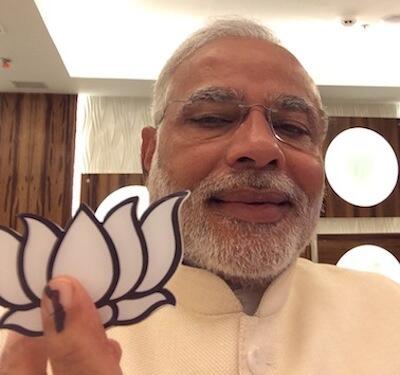With just three rounds to go between today and May 12, and just 194 seats left to fill, Indians are once again going to the polls today to elect MPs in 89 constituencies.![]()
The biggest prize of today’s voting is Gujarat, the home state of Narendra Modi, where his ruling Bharatiya Janata Party (the BJP, भारतीय जनता पार्टी) hopes to win the lion’s share of the state’s 26 seats in the Lok Sabha (लोक सभा), the lower house of India’s parliament.
Gujarat
Modi (pictured above in a ‘selfie’ posted to Twitter after voting earlier today in Ahmedabad) has served as chief minister of Gujarat since 2001, and he’s won three consecutive elections, most recently in December 2012. Much of his campaign revolves around his own stewardship of the Gujarati economy over more than a decade. The promise that Modi, as India’s next prime minister, can bring the ‘Gujarat model,’ with its high level of development, GDP growth and investment, to all of India is an alluring prospect. But it’s questionable that there’s anything like a ‘Gujarat model’ at all — it’s probably more accurate to talk about a ‘Gujarat narrative’ that begins well before Modi took office. While Modi has worked hard to bring investment to his state, and while he may be credited with some of the state’s economic success over the past 13 years, it’s not certain just how he would effect the lessons of Gujarat’s development throughout the rest of India.
But for today’s purposes, the governing Indian National Congress (Congress, भारतीय राष्ट्रीय कांग्रेस), which currently controls 11 of the state’s 26 constituencies, will almost certainly lose many of them. As in so many other states across India, Congress, under the uncertain leadership of Rahul Gandhi, seems destined to mark historical losses.
Modi is standing for election to two constituencies — Vadodara in Gujarat and Varanasi in Uttar Pradesh, which votes in the ninth and final phase of India’s elections on May 12. BJP grandee LK Advani will also be running to retain his seat in Gandhinagar, a constituency that Advani first won in 1991.
Telangana
On June 2, the new state of Telangana will come into existence out of the current state of Andhra Pradesh, with both states temporarily sharing Hyderabad as their capital.
When it becomes a discrete state, Telangana will have 17 members in the Lok Sabha, and all 17 of those seats will be determined in today’s elections (the remaining 25 constituencies in Seemandhra, the rump state of what’s left of Andhra Pradesh will vote in next week’s phase). Today’s voting will also determine all 119 members of Telangana’s new legislative assembly, thereby directing who will become the first chief minister of the new state.
It’s a three-way race among the BJP, Congress (whose national government delivered Telangana’s statehood) and the Telangana Rashtra Samithi (TRS), a local center-right party founded in 2001 to fight for Telangana’s separate statehood. Though the TRS hasn’t been allied with the BJP since 2006, it could make a natural ally for Modi if he’s looking to build a broader coalition.
Punjab
All 13 seats in Punjab will also be elected in today’s voting.
Punjab is somewhat of an outlier in Indian politics, given that it’s the only Indian state with a Sikh majority — around 60% of the state’s population of 27.7 million is Sikh, outnumbering the Hindu population (37%).
Though the outgoing prime minister, Manmohan Singh, is India’s first Sikh leader, the state’s ruling party, the Shiromani Akali Dal (ਸ਼੍ਰੋਮਣੀ ਅਕਾਲੀ ਦਲ), a Punjab-based party that represents the interests of Sikhism, is a longtime BJP ally and a stalwart of the BJP-led National Democratic Alliance (NDA). Generally, Punjabi politics is a two-way race between SAD and Congress. Parkash Singh Badal, the SAD leader, who has served as chief minister since 2007 and who has served in that role on three previous occasions in 1970-71, 1977-80 and 1997-2002, hopes that his party will make modest gains as he looks to transition power to his son, Sukhbir Singh Badal.
Among the most important contests in Punjab is in Amritsar, where senior BJP leader Arun Jaitley, the opposition leader in the upper house of the Indian parliament, the Rajya Sabha, is vying for a seat against Congress’s Amarinder Singh, who served as chief minister of Punjab from 2002-07. It’s one of the few seats where Congress seems to have the upper hand against the BJP’s ‘Modi wave.’
Other States
Uttar Pradesh, the most populous state of India, with 80 seats up for grabs in total, will see voting in another 14 constituencies, including Rae Bareli, where Sonia Gandhi, the INC co-leader, the Italian-born mother of Rahul Gandhi and the widow of the former prime minister Rajiv Gandhi, is defending the seat she has held since 2004. It’s a constituency that Feroze Gandhi held in the 1950s and that former prime minister Indira Gandhi, Sonia’s late mother-in-law, held in the late 1960s and 1970s.
Nine constituencies will vote in West Bengal, and another seven constituencies will vote in Bihar. Another constituency in Jammu and Kashmir will also vote today.
Finally, two territories — Daman and Diu, and Dadra and Nagar Haveli — will each elect their sole representative.

I think everything posted made a bunch of sense.
However, consider this, suppose you wrote
a catchier post title? I mean, I don’t wish to tell you how to run your website, but suppose you added a title that grabbed
folk’s attention? I mean India Lok Sabha elections:
Phase 7 | Suffragio is a little vanilla.You ought to peek at Yahoo’s front page and note how
they create post headlines to grab people to open the links.
You might add a video or a pic or two to grab
readers interested about what you’ve got to say. Just my opinion, it would bring
your website a little livelier.
my site – legitimate surveys
Ƭhanks for finakly talkinmg about > India Lok Ѕɑbha elections:
Phase 7 | Suffragio < Liked it!